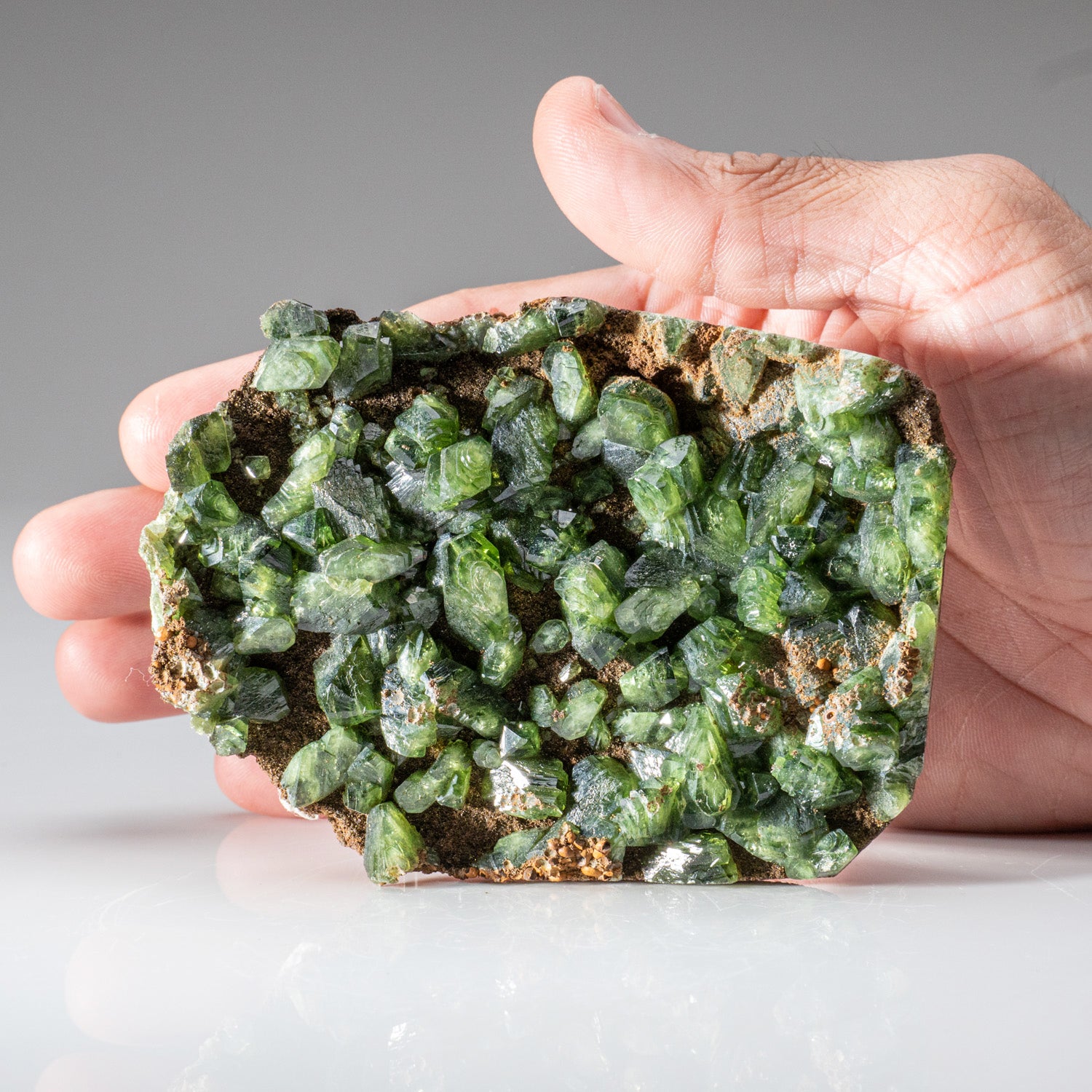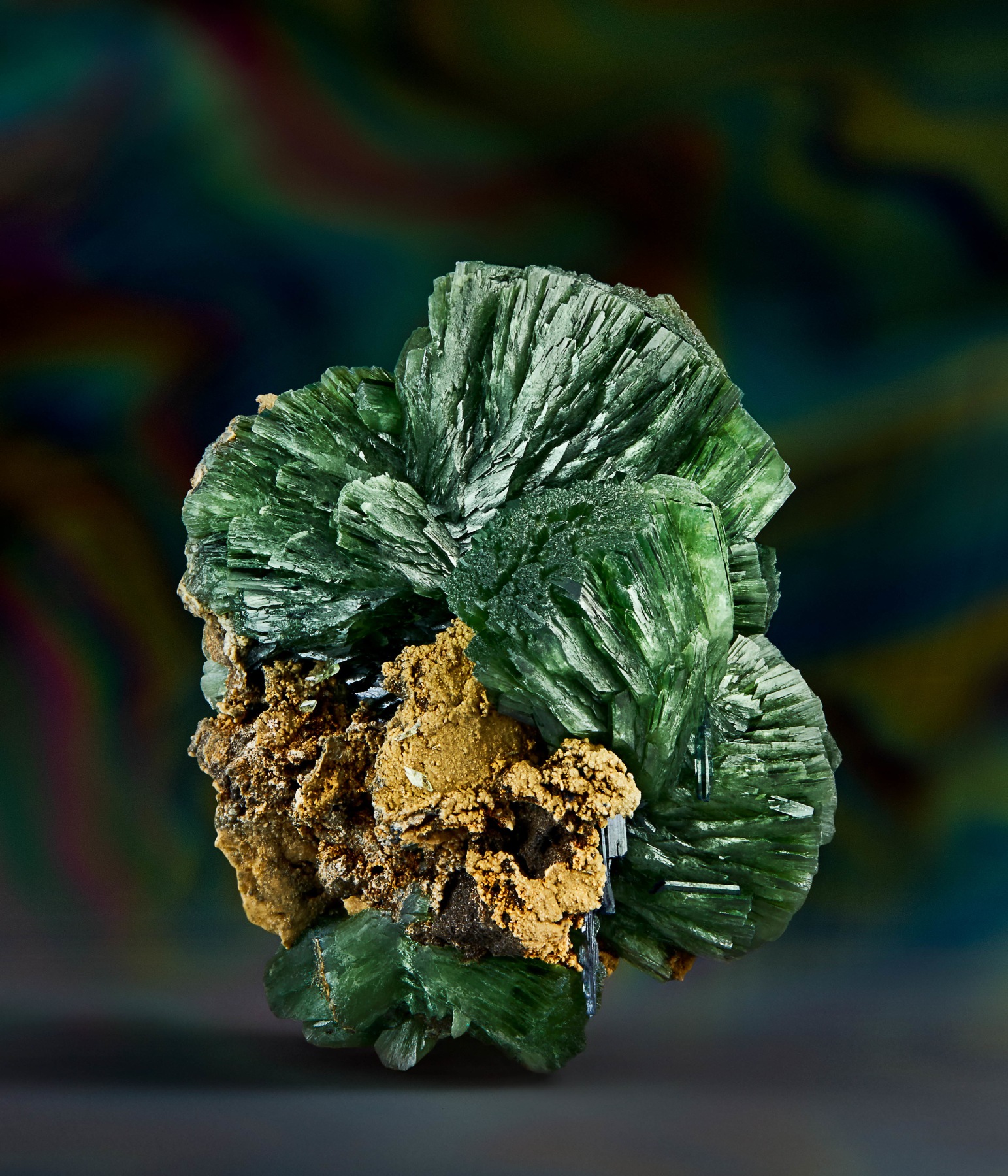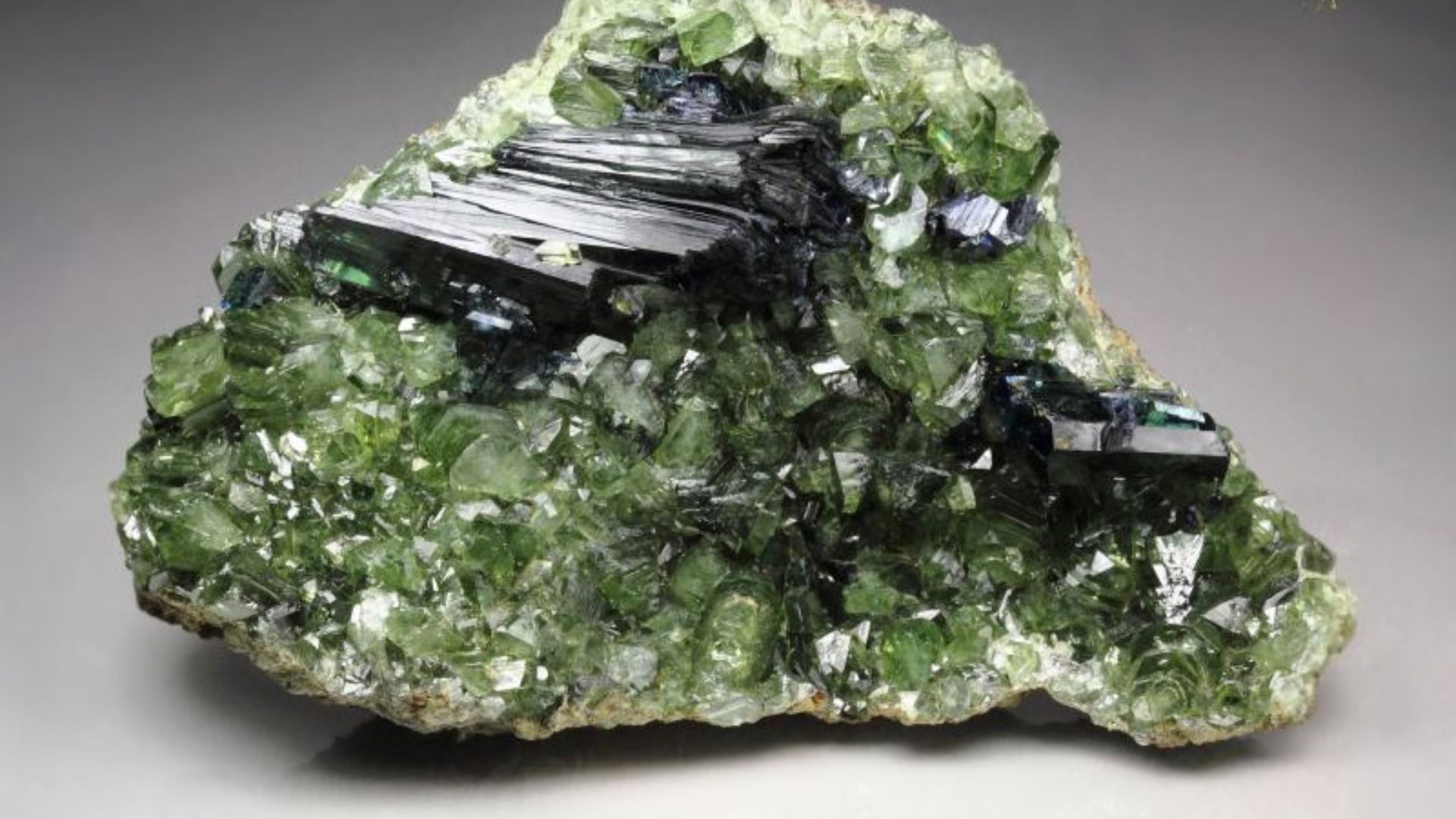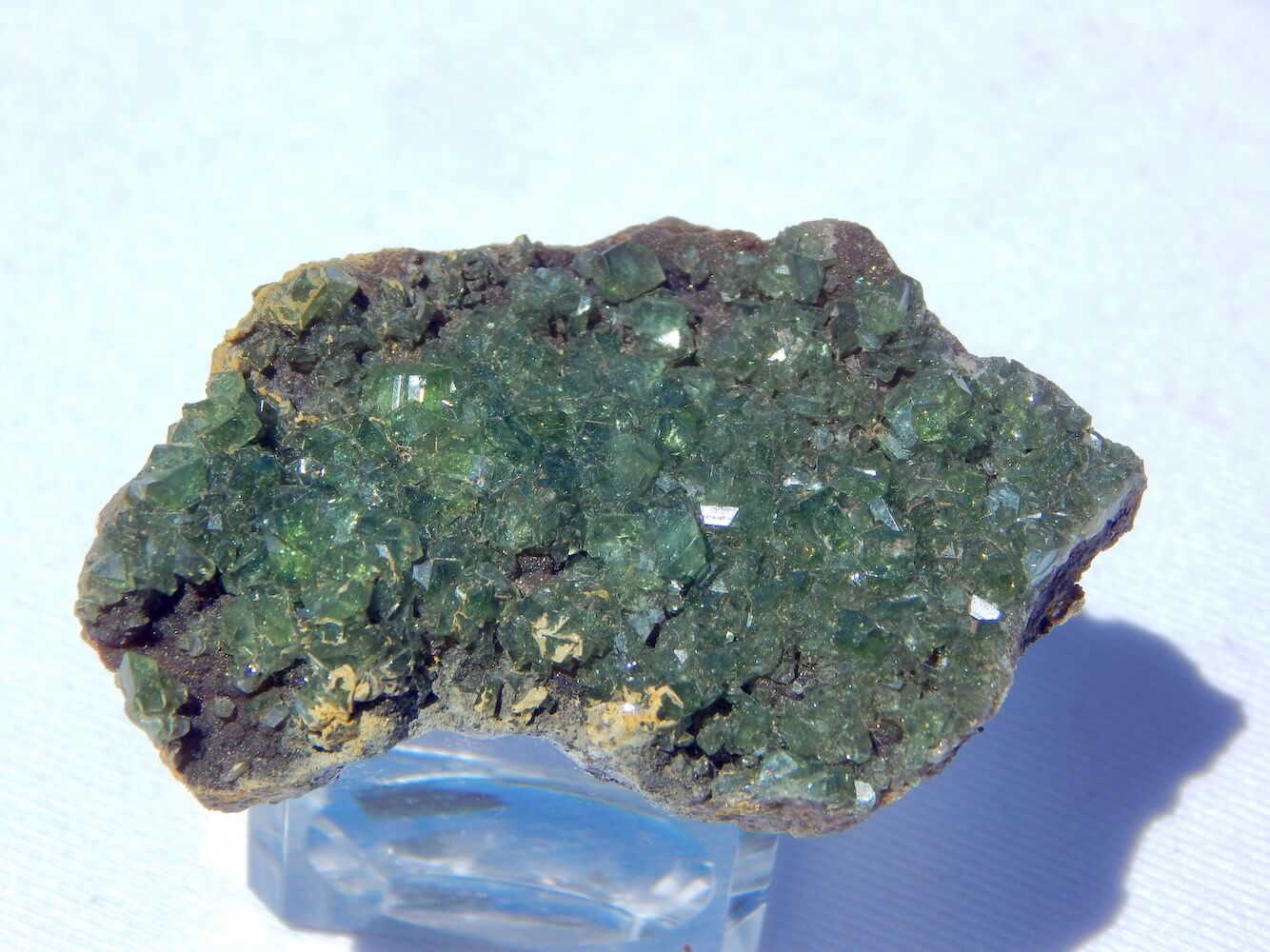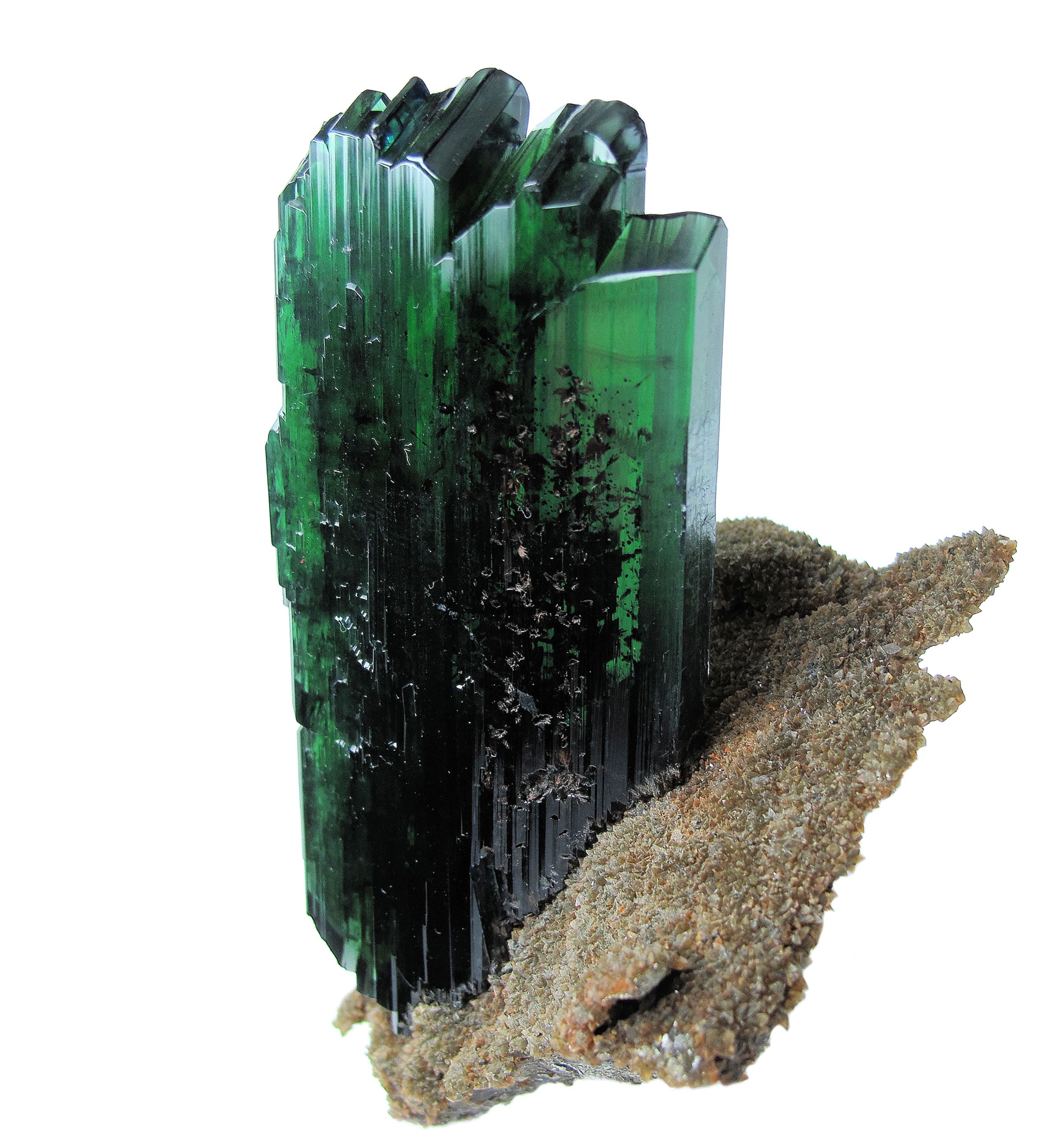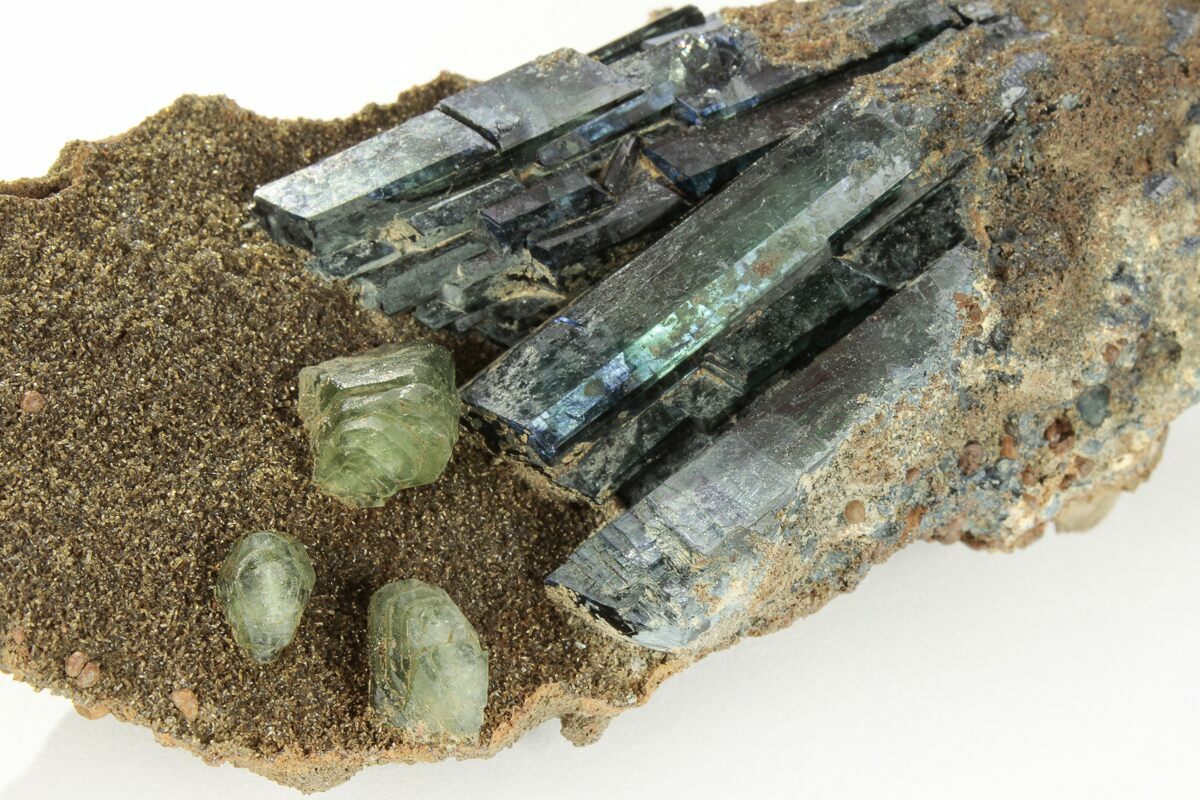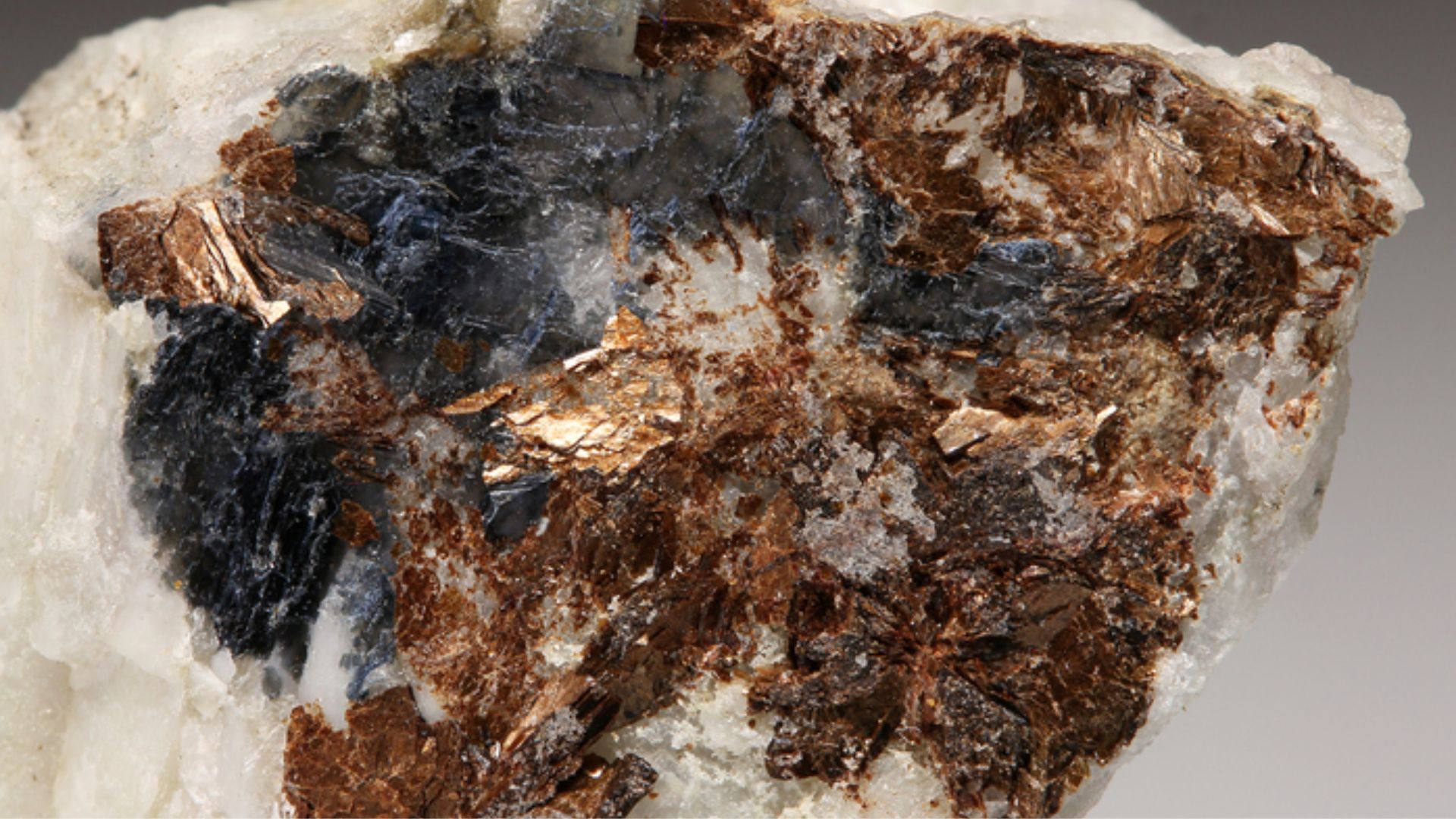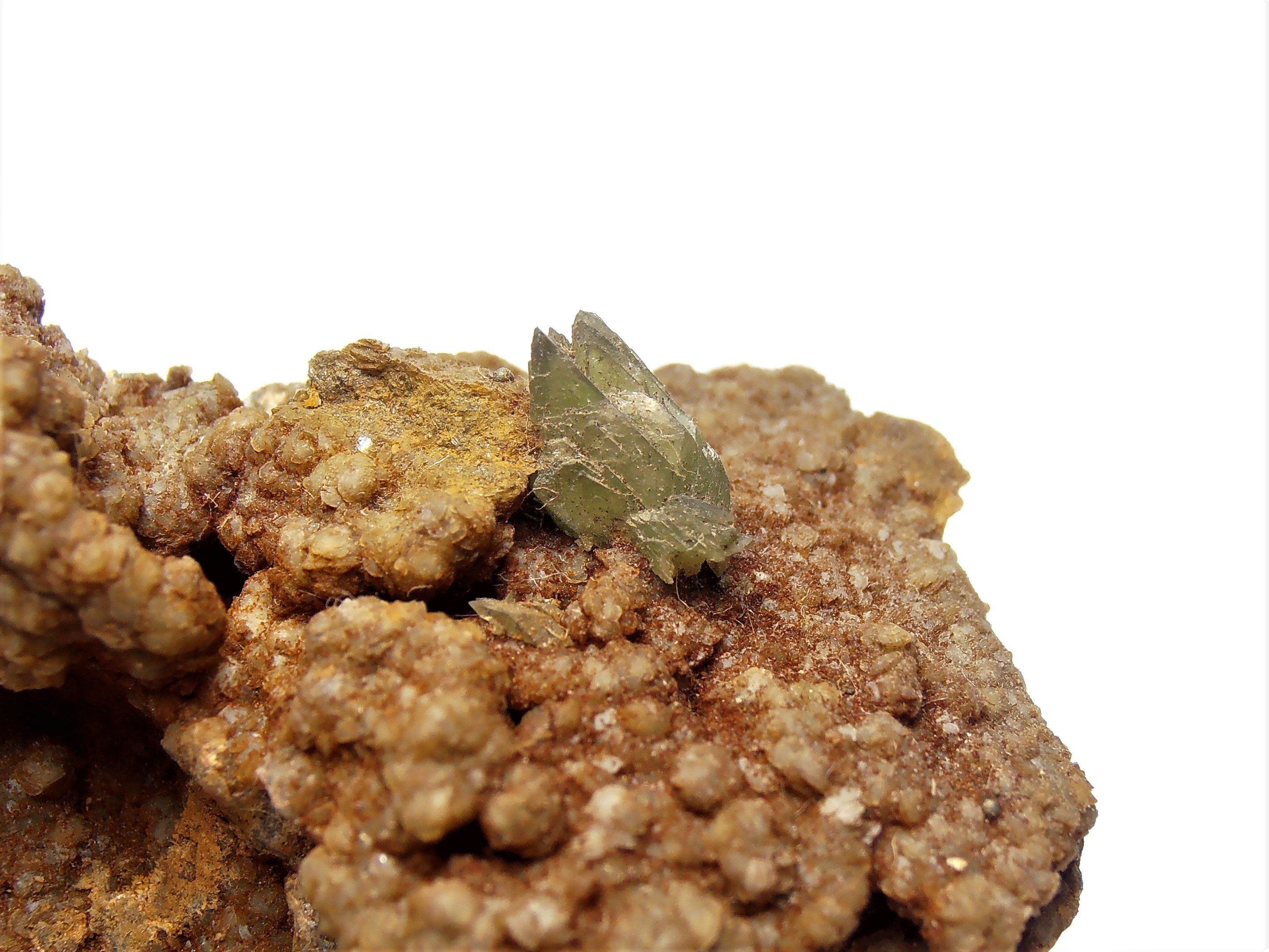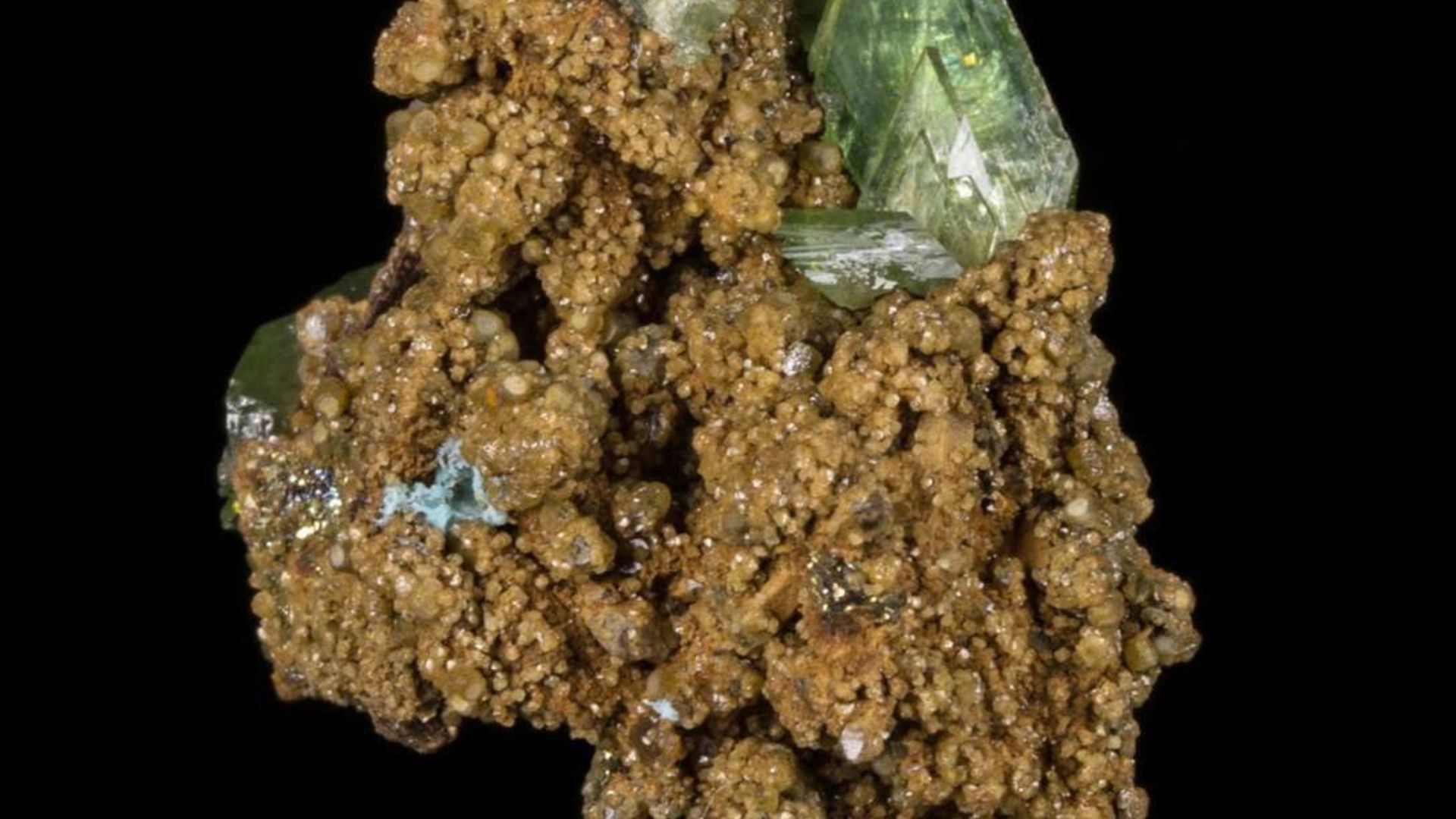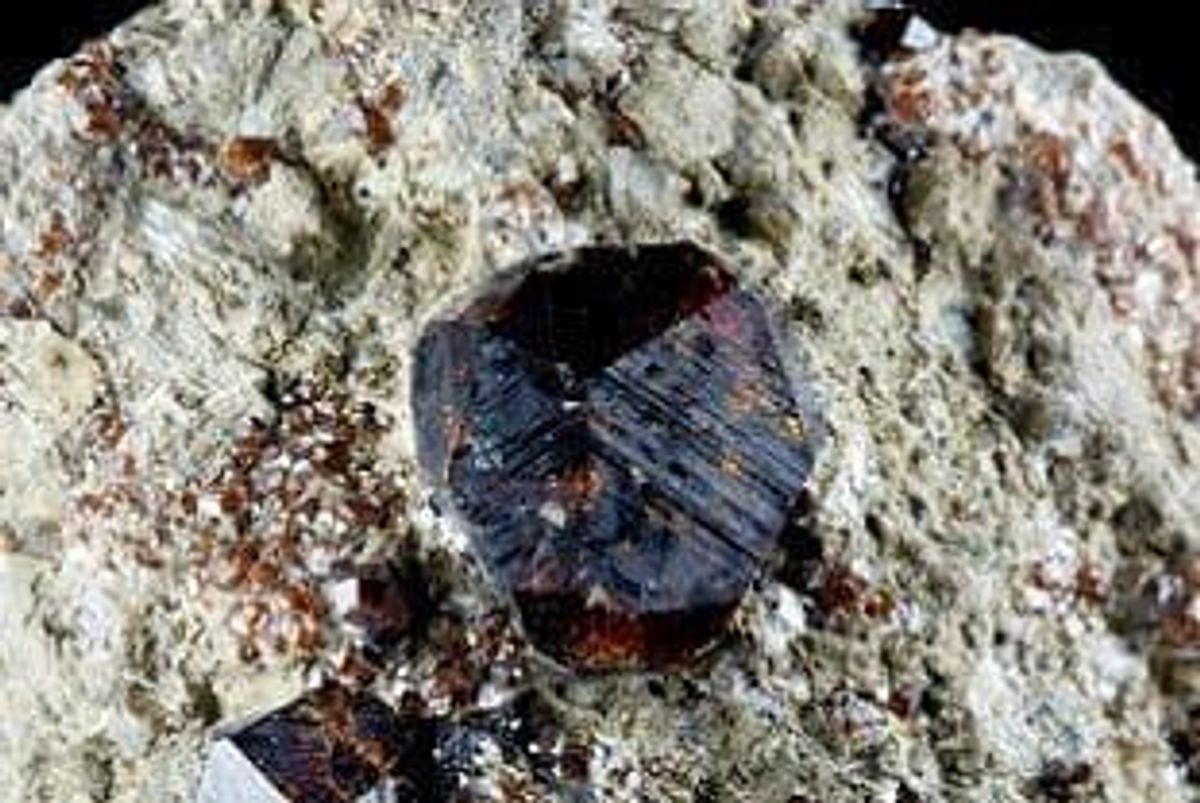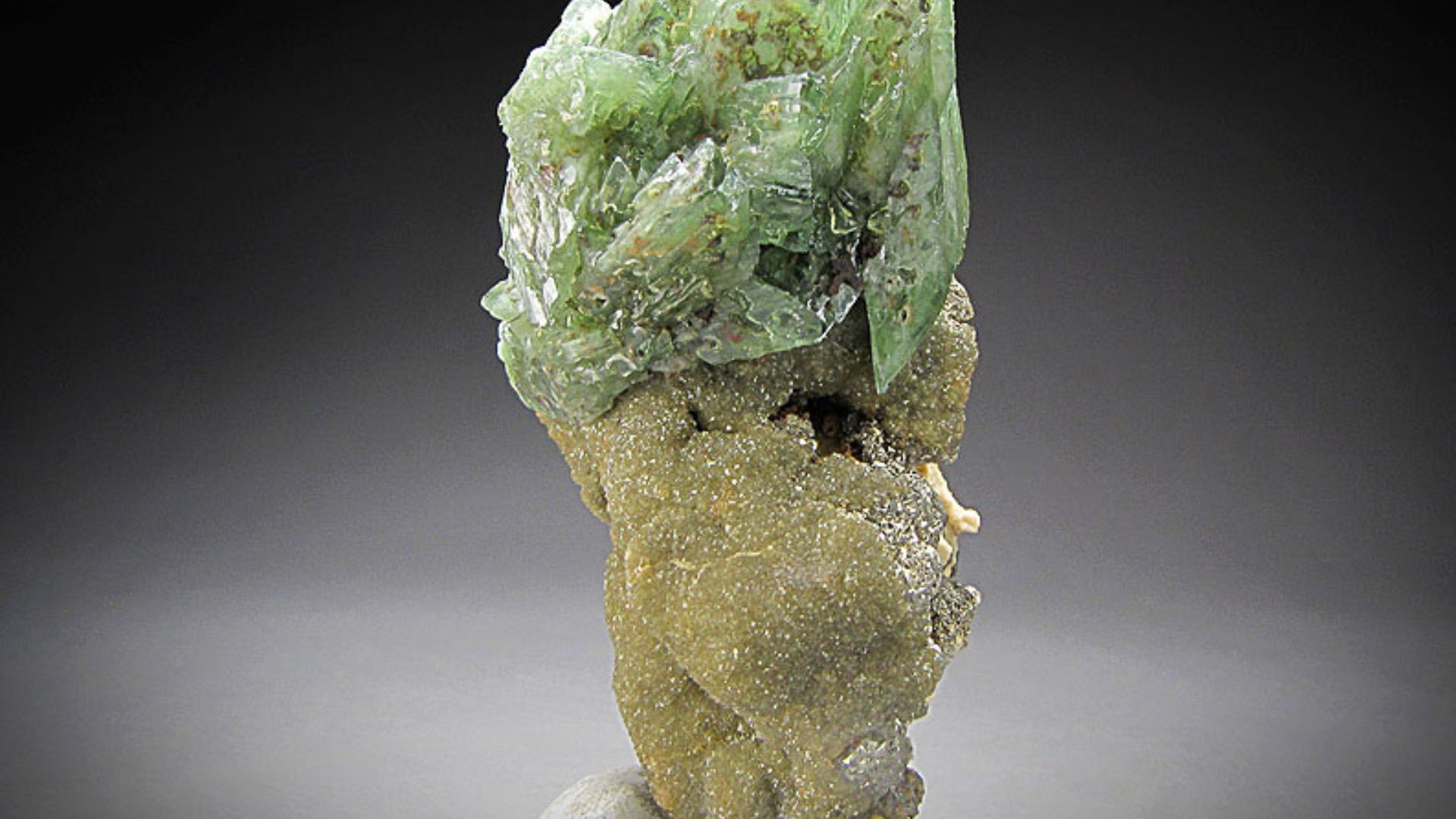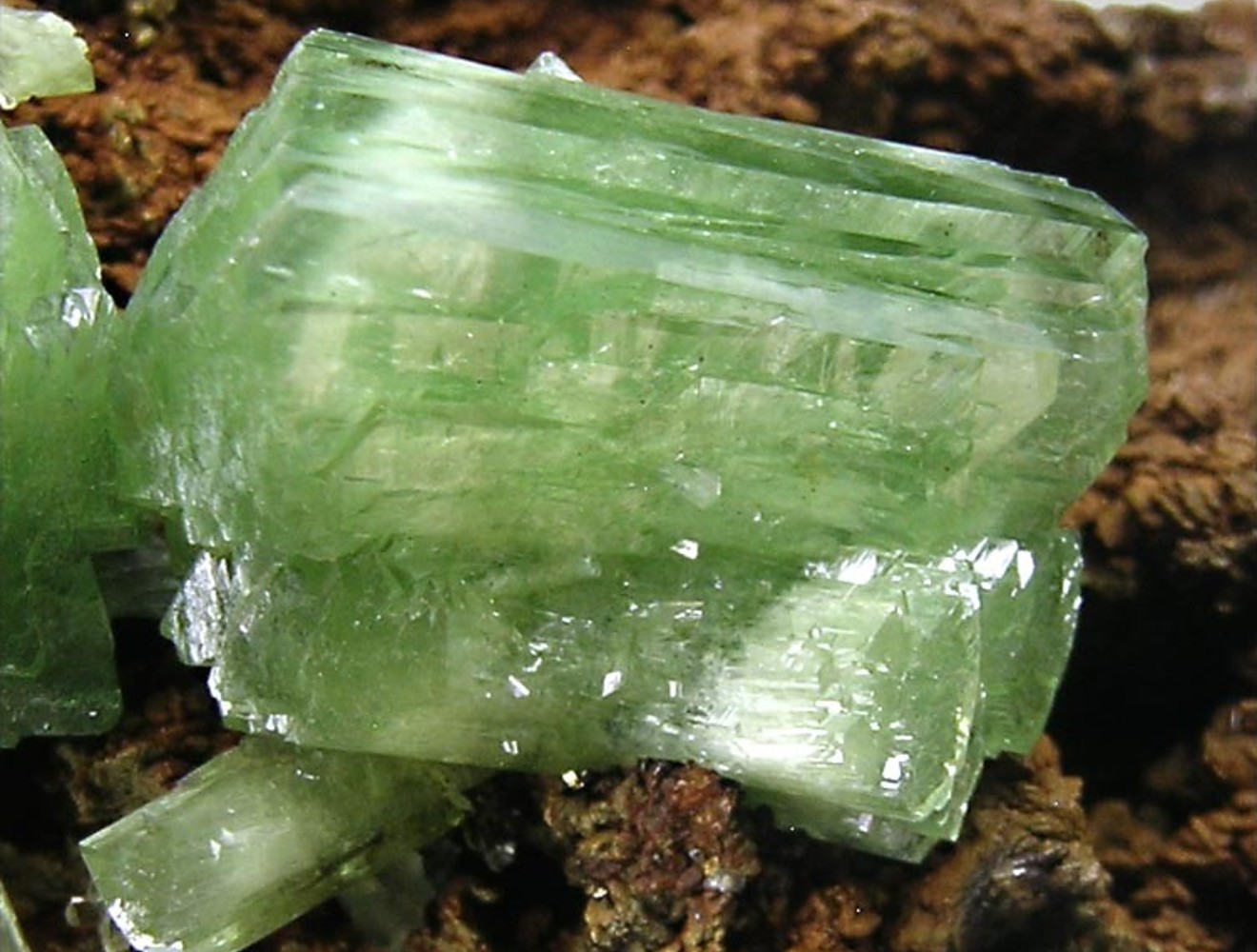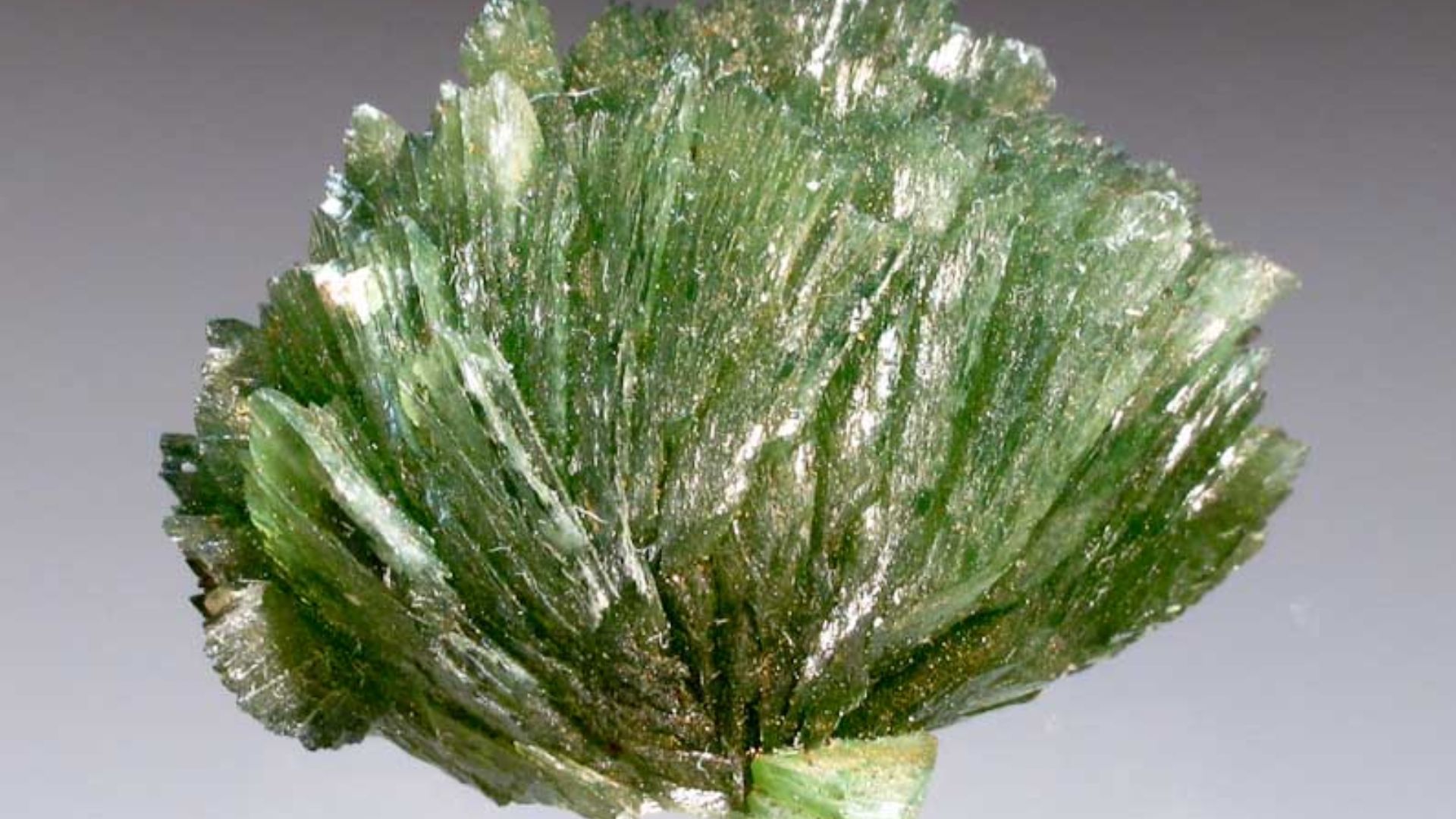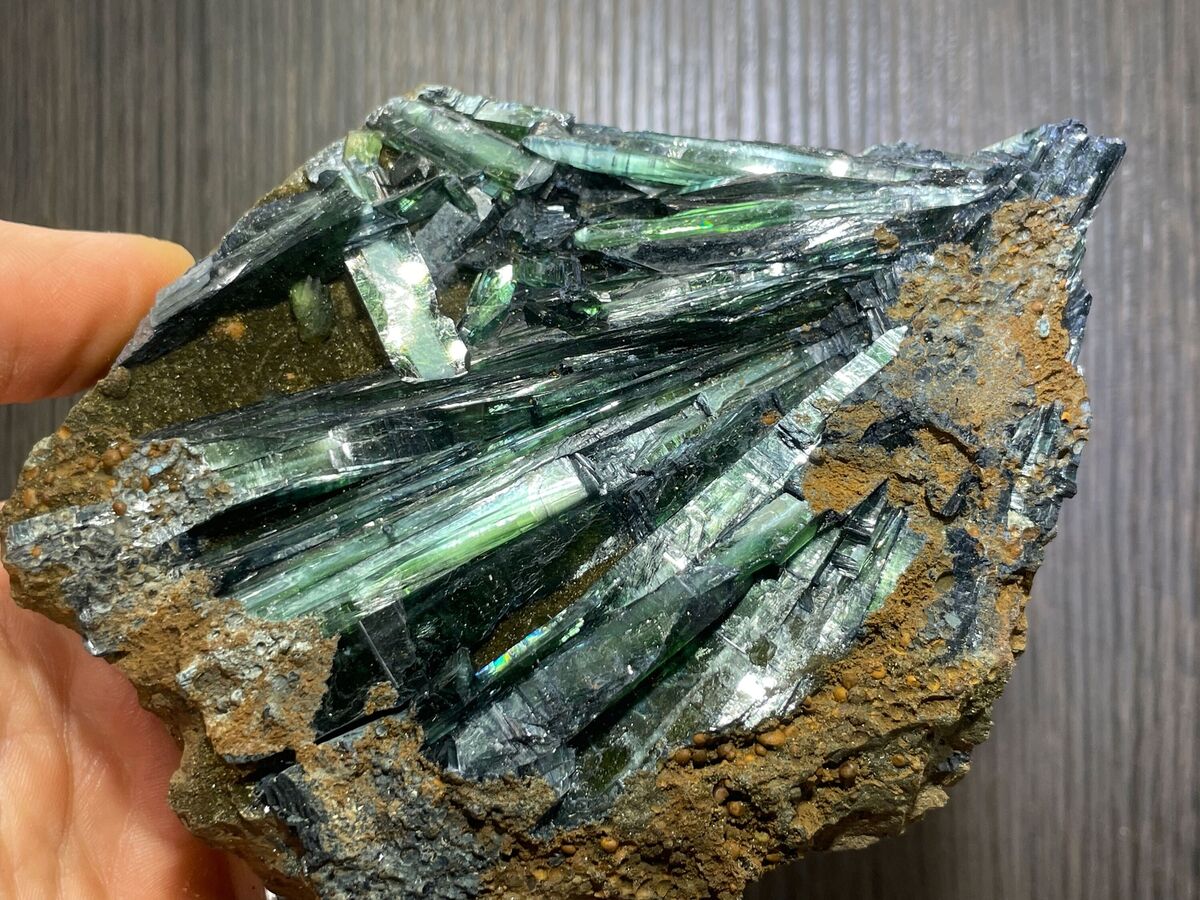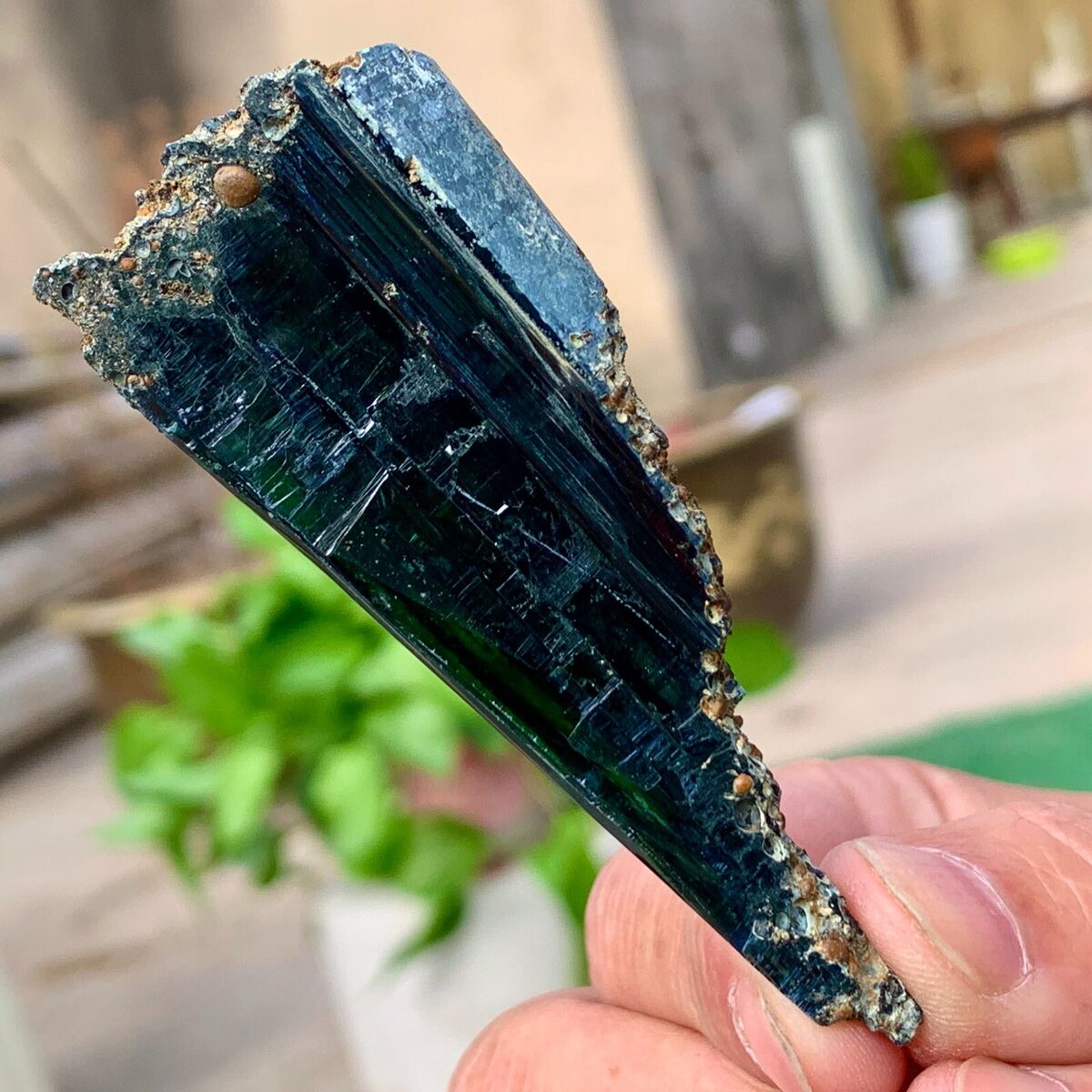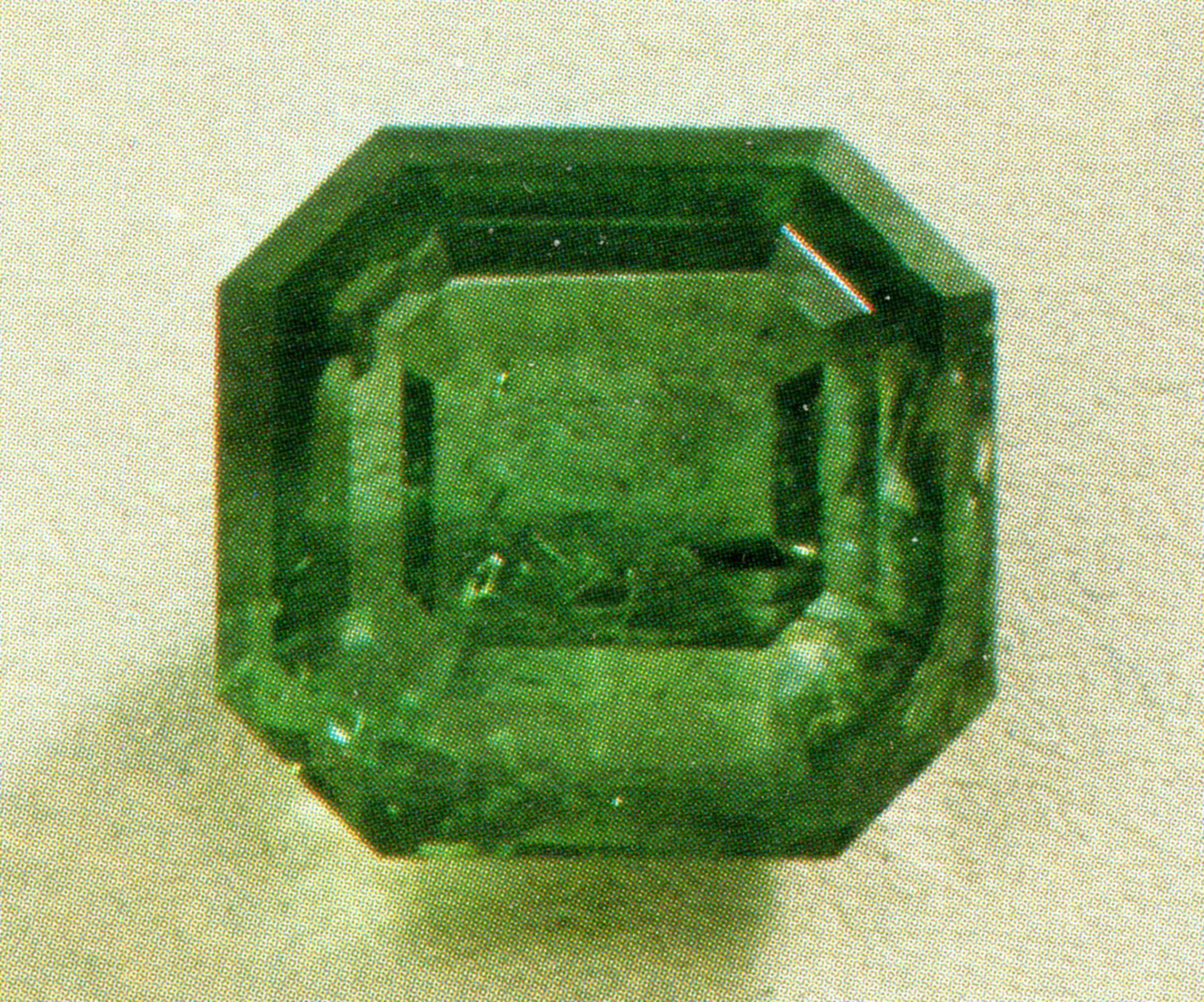
Imagine stumbling upon a mineral that shimmers with an iridescent, almost ethereal glow. This is ludlamite. A rare and captivating mineral. Ludlamite possesses a unique beauty. It captivates mineral enthusiasts and collectors worldwide.
Ludlamite is a rare iron arsenate mineral. Its chemical formula is Fe3(AsO4)2·4H2O. It crystallizes in the triclinic system. Ludlamite often forms tabular or prismatic crystals. It has a distinct pearly to vitreous luster.
The most striking characteristic of ludlamite is its captivating color. Specimens typically exhibit a range of vibrant greens. Colors can vary from pale apple green to deep emerald hues. In certain lighting conditions, these colors can shift and shimmer. This creates an iridescent effect.
Ludlamite Color
Ludlamite typically exhibits a range of greenish colors. The most common shades include olive green and brownish-green. These hues are a result of their chemical composition, which contains elements like iron, manganese, and phosphorus.
The specific shade of green can vary depending on the mineral's impurities and the conditions under which it is formed. This distinctive coloration is one of the characteristics that make Ludlamite visually appealing to collectors and researchers in the field of mineralogy.
Formation And Occurrence
Ludlamite forms in environments rich in iron and arsenic. It typically arises from the oxidation of arsenic-bearing minerals in reducing environments. This process often occurs within oxidized zones of arsenic-bearing deposits.
Ludlamite is also frequently found in granite pegmatites. It forms as a hydrothermal alteration product of earlier phosphate-bearing minerals.
While not widespread, ludlamite has been discovered in a few notable locations around the world. Some of the most significant finds include:
- Cornwall, England. The type locality for ludlamite.
- Utah, USA.
- Blackbird Mine, Lemhi County, Idaho, USA. A renowned source for gem-quality ludlamite.
- Other locations include Germany, Austria, Australia, New Hampshire, and South Dakota (USA), Bolivia, Brazil, and Mexico.
History And Discovery
Ludlamite was first described in 1877. It was discovered by British mineralogist Henry Clifton Sorby. It was named after Henry Ludlam, another English mineralogist. The initial discovery occurred at the Wheal Jane mine in Cornwall, England.
The discovery of ludlamite provided valuable insights into early geological processes. It helped geologists understand the formation of mineral deposits. The mineral's unique crystal structures and distinctive properties captivated early geologists and collectors.
Ludlamite: A Collector's Perspective
Ludlamite is a highly sought-after mineral among collectors. Its vibrant colors and well-formed crystals are visually stunning.
The value of ludlamite specimens can vary depending on several factors. These factors include size, color, quality, and provenance. Specimens from classic localities are often highly prized.
While beautiful, ludlamite is a delicate gemstone. It has a low hardness (3.5 on the Mohs scale). It also has perfect cleavage. These factors make it impractical for most jewelryapplications. Ringuse is discouraged. It is best suited for occasional wear in protective settings.
Properties Of Ludlamite - Understanding Its Unique Characteristics
Ludlamite is a rare iron arsenate mineral. Its chemical formula is Fe3(AsO4)2·4H2O. It crystallizes in the triclinic system.
| Property | Value |
| Chemical Formula | Fe3(AsO4)2·4H2O |
| Crystal System | Monoclinic |
| Space Group | P21/b |
| Unit Cell Parameters | a = 10.541(5) Å, b = 4.646(4) Å, c = 9.324(5) Å, β = 100.43° |
| Color | Apple-green to bright green |
| Luster | Sub-vitreous, resinous, greasy. Pearly on cleavage {001} |
| Transparency | Transparent, Translucent |
| Hardness | 3.5 on the Mohs scale |
| Cleavage | Perfect on {001}, indistinct on {100} |
| Streak | Pale greenish white |
| Density | 3.12 - 3.19 g/cm3 |
| Optical Properties | Biaxial (+) |
| Refractive Index | nα = 1.650 - 1.653, nβ = 1.669 - 1.675, nγ = 1.688 - 1.697 |
| 2V Angle | Measured: 82°, Calculated: 86° to 88° |
| Birefringence | δ = 0.038 - 0.044 |
| Surface Relief | High |
| Dispersion | r > v perceptible |
| Optical Extinction | Y = b; Z ∧ c = -67° |
| Pleochroism | Non-pleochroic |
Varieties And Notable Occurrences
Ludlamite exhibits a range of colors and crystal habits. This leads to several notable varieties.
- Classic Olive-Green Ludlamite:The most widely recognized variety. It is known for its rich and captivating olive-green hue.
- Brownish-Green Ludlamite:Showcases a mesmerizing brownish-green hue.
Ludlamite occurs in various geological settings. These include:
- Hydrothermal Veins:Often found in association with other minerals.
- Pegmatites:Particularly in complex granitic pegmatites.
- Phosphate Deposits:Occurs in association with other phosphate minerals.
10 Exceptional Types Of Ludlamite
Here are the ten exceptional types of Ludlamite;
Classic Olive-Green Ludlamite
The classic olive-green Ludlamite is the most widely recognized variety, known for its rich and captivating hue. Its distinctive coloration is a result of its chemical composition, and it remains a favorite among collectors and enthusiasts.
Brownish-Green Ludlamite
This variation of Ludlamite exhibits a mesmerizing brownish-green hue. It showcases a unique interplay of colors, adding to its allure and making it a prized find for those seeking diverse ludlamite specimens.
Prismatic Crystal Formation
Prismatic Ludlamite is characterized by its well-defined, elongated crystal structures. These striking formations add an extra dimension of beauty and interest for collectors and researchers, making them highly sought after.
Ludlamite In Hydrothermal Veins
Ludlamite found in hydrothermal veins is of particular interest to geologists. This type often occurs in association with other minerals, offering valuable insights into the geological processes that led to its formation.
Ludlamite In Pegmatites
Pegmatitic Ludlamite stands out for its occurrence in these coarse-grained igneous rocks. The unique conditions within pegmatites contribute to the distinct characteristics of Ludlamite found in these formations.
Ludlamite In Phosphate Deposits
Ludlamite's presence in phosphate deposits underscores its geological significance. Its association with phosphorous-rich environments offers crucial clues about the Earth's ancient geological processes.
Ludlamite As An Indicator Mineral
Certain types of Ludlamite serve as indicator minerals for valuable ores and metals. This role in mineral exploration and prospecting further enhances its importance in the field of economic geology.
Ludlamite In Skarn Deposits
Skarn deposits host Ludlamite alongside other minerals, creating unique geological environments. The interplay between Ludlamite and these surrounding minerals offers a fascinating subject for study.
Ludlamite With Quartz And Pyrite
Ludlamite's association with quartzand pyrite in specific deposits creates visually stunning mineral assemblages. These combinations add an extra layer of complexity and beauty to ludlamite specimens.
Ludlamite In Sulfide Ore Deposits
Ludlamite's occurrence in sulfide ore deposits highlights its relevance in the mining industry. Understanding its presence in these contexts aids in the efficient extraction of valuable resources.
Also Read: Top 16 Green Colored Gemstones You Need To Have
Folklore And Metaphysical Beliefs
Disclaimer:
- The following are based on traditional beliefs and are not scientifically proven.
- These beliefs should not be considered medical or scientific advice.
Traditional Beliefs Associate Ludlamite With Various Metaphysical Properties:
- It is believed to help balance and harmonize one's energy, promoting a sense of equilibrium and stability.
- Ludlamite is thought to clear mental clutter, allowing for clearer thinking and improved cognitive function.
- It may assist in releasing past traumas and emotional wounds.
- Ludlamite may impart a sense of inner strength and resilience, helping individuals face challenges with courage and determination.
- In some holistic practices, Ludlamite is believed to support the physical healing process.
- It is thought to encourage the flow of positive energy throughout the body.
- Ludlamite is believed to enhance one's connection to higher states of consciousness.
- While associated with higher energies, it is also believed to have grounding properties.
- It is thought to heighten intuitive abilities, allowing individuals to trust their inner wisdom.
- In some spiritual practices, Ludlamite is believed to align with the heart and third eye chakras.
See Also: Heart Chakra Crystals - A Guide To Balancing Your Center
Healing Properties Of Ludlamite
Here are the healing properties of Ludlamite.
Energetic Balance
Ludlamite is believed to help balance and harmonize one's energy, promoting a sense of equilibrium and stability. This property may assist individuals in finding emotional and spiritual balance.
Enhanced Focus And Concentration
Some practitioners suggest that Ludlamite can aid in improving mental focus and concentration. It is thought to clear mental clutter, allowing for clearer thinking and improved cognitive function.
Promotes Emotional Healing
Ludlamite is associated with emotional healing and is believed to assist in releasing past traumas and emotional wounds. It may help individuals process and move forward from difficult experiences.
Strength And Resilience
Ludlamite can impart a sense of inner strength and resilience, helping individuals face challenges with courage and determination. This property may be beneficial in times of adversity.
Supports Physical Healing
In some holistic practices, Ludlamite is believed to support the physical healing process. It may be used as a complementary tool alongside traditional medical treatments.
Promotes Positive Energy Flow
Ludlamite is thought to encourage the flow of positive energy throughout the body. It may contribute to a sense of vitality and well-being.
Facilitates Spiritual Growth
For some individuals, Ludlamite is considered a stone that supports spiritual growth and development. It is believed to enhance one's connection to higher states of consciousness.
Aids In Grounding
While Ludlamite is associated with higher energies, it is also believed to have grounding properties. It can help individuals stay rooted and connected to the present moment.
Enhances Intuition
Ludlamite is thought to heighten intuitive abilities, allowing individuals to trust their inner wisdom and make decisions with greater clarity and confidence.
Chakra Alignment
In some spiritual practices, Ludlamite is believed to align with the heart and third eye chakras. This alignment is thought to facilitate a deeper connection to intuition, compassion, and higher consciousness.
Related: Healing Gemstones - Complete Guide <year> [Update]
Benefits Of Ludlamite - A Treasure Trove Of Advantages
Ludlamite has many benefits. Let us discuss it.
Phosphorus Enrichment In Soil
Ludlamite's rich phosphorous content makes it a valuable source of this essential nutrient for plants. When used as a fertilizer, Ludlamite contributes to healthier and more robust crop growth.
Sustainable Agriculture Practices
Utilizing Ludlamite in agriculture supports sustainable farming methods. Its phosphorous contribution aids in reducing the reliance on synthetic fertilizers, promoting environmentally friendly cultivation practices.
Indicator Mineral For Valuable Ores
Certain types of Ludlamite serve as indicators for the presence of valuable ores and metals. This characteristic is invaluable in mineral exploration, aiding in the efficient extraction of precious resources.
Geological Insights
The occurrence of Ludlamite in specific geological environments provides critical information about ancient geological processes. Its presence in hydrothermal veins, pegmatites, and skarn deposits offers valuable insights for researchers and geologists.
Versatile Industrial Applications
Ludlamite finds applications in various industrial processes beyond its use as a fertilizer. Its phosphorous-rich composition contributes to the production of essential materials, supporting industries worldwide.
Aesthetic Appeal In Jewelry
Ludlamite's captivating greenish hues and distinctive crystal formations make it a sought-after gemstone for jewelry enthusiasts and collectors. Artisans transform raw ludlamite specimens into exquisite pieces, showcasing their natural beauty.
Historical Significance In Mineralogy
The discovery of Ludlamite by William Ludlam in the 19th century marked a significant milestone in the field of mineralogy. Its unique properties and crystal structures continue to intrigue researchers and collectors to this day.
Contributions To Economic Geology
Ludlamite's presence in specific ore deposits aids in economic geology endeavors. Understanding its association with valuable minerals helps streamline mining operations and maximize resource extraction.
Promoting Responsible Mining Practices
The extraction of Ludlamite necessitates responsible mining practices. It includes proper waste management and reclamation efforts to minimize the environmental impact of mining activities.
Continued Research And Advancements
Ongoing research in Ludlamite's extraction, processing, and applications drives innovation in the field. This leads to the development of more sustainable extraction methods and expands the mineral's potential benefits.
Practical Applications Of Ludlamite - From Agriculture To Industry
Below are discussed the practical application of Ludlamite;
Phosphorous-Enriched Fertilizers
Ludlamite serves as a valuable source of phosphorus, a vital nutrient for plant growth. It is utilized in the production of fertilizers, enriching soil, and promoting healthier and more robust crop yields.
Enhancing Crop Quality And Yield
By incorporating ludlamite-based fertilizers into agricultural practices, farmers can optimize crop production. The phosphorous content aids in root development, flowering, and overall plant vigor, resulting in higher-quality harvests.
Sustainable Agriculture Practices
The use of ludlamite-based fertilizers supports sustainable farming methods. It reduces the dependency on synthetic fertilizers, minimizing environmental impacts associated with their production and use.
Contribution To The Pharmaceutical Industry
Ludlamite's unique chemical composition finds applications in pharmaceuticals. It serves as a source of phosphorus for various medicinal compounds, contributing to the development of pharmaceutical products.
Manufacture Of Specialty Chemicals
The phosphorous content in Ludlamite is harnessed for the production of specialty chemicals. These chemicals find applications in diverse industries, including agriculture, pharmaceuticals, and manufacturing.
Metallurgical Processes
Ludlamite's presence in certain ore deposits makes it an essential mineral in metallurgical processes. It contributes to the extraction of valuable metals, playing a crucial role in the production of alloys and other metal products.
Ceramic And Glass Industries
In the ceramic and glass industries, Ludlamite is utilized for its phosphorous content. It acts as a fluxing agent, aiding in the melting process and enhancing the properties of ceramic and glass products.
Research And Geological Studies
Ludlamite's occurrence in specific geological environments provides valuable insights for researchers and geologists. Studying ludlamite formations helps in understanding ancient geological processes and the construction of mineral deposits.
Gemstone And Jewelry Industry
Ludlamite's captivating greenish hues and distinctive crystal formations make it a sought-after gemstone. Skilled artisans transform raw ludlamite specimens into exquisite jewelry pieces, appealing to collectors and jewelry enthusiasts.
Development Of Advanced Materials
The phosphorous-rich nature of Ludlamite contributes to the development of advanced materials. It is used in the creation of specialized compounds and composites with unique properties for various industrial applications.
How To Identify Ludlamite?
Ludlamite can be identified by its characteristic green color, often with an iridescent sheen. It typically forms tabular or prismatic crystals with a pearly to vitreous luster.
Distinguishing Ludlamite from Vivianite:
- Ludlamite has a higher refractive index (1.650-1.697) and specific gravity (3.12-3.19) compared to vivianite (1.569-1.675 and 2.64-2.68).
- Vivianite exhibits pleochroism (color change with viewing direction), while Ludlamite does not.
- Vivianite has a lower hardness (1.5 to 2) than ludlamite (3.5).
- Vivianite has a streak color that can range from colorless to blue, while ludlamite has a pale, greenish white streak.
Note:Scratch and streak testing are not recommended for finished gems.
How To Use Ludlamite Gemstone
The Ludlamite gemstone is used for its metaphysical characteristics in a number of different ways. Wearing it as a necklace or bracelet will help you keep it near your body all day long. You may also meditate with it on your heart chakra by keeping it in your pocket.
You may either put Ludlamite directly on an injury or hold it in your palm and concentrate on the healing process to have the same effect.
Does Ludlamite Make A Good Jewelry Stone?
Faceted ludlamites may be exceptionally brilliant in addition to having a stunning hue. This mineral is very uncommon and much more so in sizes suitable for cutting. They have a superb cleavage and a low hardness of 3.5.
Because of this, Ludlamite is not a stone that is easily cut or used as jewelry. It would need a secure setting and should be used seldom, if at all, as a ringtone. It is recommended that they be used as earrings, pendants, or brooches.
Ludlamites are rare enough that they are more likely to be found in mineral collections than in jewelry collections.
Caring For Ludlamite - Tips For Preservation And Display
Let us discuss how to care for Ludlamite;
Handle With Care:
- Avoid touching ludlamite specimens with bare hands, as oils and dirt can affect the surface over time.
- Wear gloves when handling specimens to minimize contact with skin oils.
Avoiding Direct Sunlight
Direct exposure to sunlight can lead to fading or alteration of Ludlamite's color over time. It's advisable to display ludlamite specimens in a location where they won't be subjected to prolonged sunlight.
Protecting From Moisture
Ludlamite should be kept away from moisture to prevent any potential deterioration or changes in its properties. Store it in a dry environment and avoid exposing it to damp conditions.
Avoiding Abrasive Surfaces
When displaying Ludlamite, ensure that it is not in contact with abrasive surfaces. Placing it on rough materials can lead to scratches or damage to the crystal structure.
Gentle Cleaning Methods
If cleaning is necessary, use a soft, clean cloth or a brush with soft bristles. Avoid harsh chemicals or solvents, as they can damage the surface of the mineral.
Proper Storage And Display
- Store in a secure and stable location, away from areas with high traffic or the risk of accidental knocks.
- Consider using display cases or enclosures to protect specimens from dust, insects, and other environmental factors.
Avoiding Extreme Temperatures
Extreme temperatures can potentially harm Ludlamite. Avoid storing or displaying it in areas prone to rapid temperature fluctuations, such as near heaters or in direct airflow from air conditioners.
Regular Inspection
Periodically inspect Ludlamite for any signs of damage, discoloration, or changes in appearance. Early detection of any issues allows for prompt intervention and preservation measures.
Using Display Cases Or Enclosures
For valuable or delicate ludlamite specimens, consider placing them in a display case or enclosure. It provides an extra layer of protection from dust, moisture, and accidental contact.
Seeking Professional Advice
If you have a particularly rare or valuable ludlamite specimen, consider consulting with a mineralogist or conservator for specific care instructions tailored to your representative.
Ludlamite - FAQs
Where Is Ludlamite Typically Found?
Ludlamite is often found in hydrothermal veins, pegmatites, and skarn deposits. It can also occur in phosphate-rich environments and as an indicator mineral in certain ore deposits.
What Is Ludlamite's Mohs Hardness?
Ludlamite has a Mohs hardness ranging from 3.5 to 4, making it moderately hard.
What Is The Color Range Of Ludlamite?
Ludlamite typically exhibits shades of olive-green to brownish-green. The specific coloration can vary depending on impurities and geological conditions.
What Is The Spiritual Meaning Of Ludlamite?
Ludlamite is considered a stone of spiritual development and awakening in spiritual practices. It is commonly utilized in meditation or energy work to strengthen the connection to the divine and reach elevated states of awareness.
What Is The Difference Between Ludlamite And Vivianite?
- Color: Vivianite often darkens to blue or blackish-blue shades, while blue is rare for Ludlamite.
- Pleochroism: Vivianite exhibits intense pleochroism, meaning it shows different colors when viewed from different angles, while Ludlamite does not display pleochroism.
- Refractive Index: Vivianite has a lower refractive index, ranging from 1.569 to 1.675, compared to Ludlamite.
- Density: Vivianite has a lower density, ranging from 2.64 to 2.68, while Ludlamite is denser.
Conclusion
Ludlamite symbolizes the Earth's geological diversity and complexity. Its unique properties, geological significance, and numerous applications have cemented its place in mineralogy.
Ludlamite has captivated scientists, collectors, and enthusiasts since its discovery by William Ludlam, and it still plays important roles in industry and jewelry today. As we continue to explore the Earth's interior, Ludlamite remains a valuable resource that will be admired for generations.
